How Light from Electronics Affects Sleep
If you’re having trouble sleeping, it may be your electronics.
As I wrote in How Light effects Melatonin and Sleep, the hormone melatonin helps regulate our sleep & wake cycles (the circadian clock). Production of this hormone is triggered by darkness and inhibited by light, and that helps explain why we have trouble with jet lag, shift work, and winter months with fewer daylight hours. But it’s not just the availability or intensity of light; it’s also the color temperature, and it’s been that way for thousands of years.
We’re genetically programmed to get sleepy at dark and wake in the light of day, but man’s DNA has not evolved as fast as electricity or electronics. The flickering flame of a campfire, with its warm orange glow, plays a role in getting our bodies ready for sleep, as does the bright morning sunlight that helps us wake up. So it’s not surprising that the cool blue light of a television, PC, or tablet does the same thing.
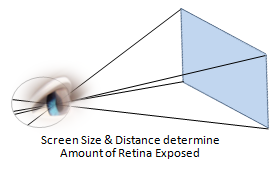 Screen size and distance also plays a role. As shown in the illustration, much less of the light from a 27″ TV across the room contacts the retina than the same TV placed closer, or a much larger TV at the same distance. Because of the wider viewing angle, even a notebook or tablet PC with a much smaller screen can flood the eyes with more light because it’s much closer, and that’s why viewing electronics before bed is a bad idea.
Screen size and distance also plays a role. As shown in the illustration, much less of the light from a 27″ TV across the room contacts the retina than the same TV placed closer, or a much larger TV at the same distance. Because of the wider viewing angle, even a notebook or tablet PC with a much smaller screen can flood the eyes with more light because it’s much closer, and that’s why viewing electronics before bed is a bad idea.
You can minimize the negative effects of the bluish light by simply turning down the brightness or changing the system settings so this happens automatically. My wife’s iPad-2 has a built-in camera, for example, so it can automatically adjust brightness to match the ambient room lighting, maximizing brightness in sunlight or minimizing it at night. My older iPad, on the other hand, has no camera or way to know if the room is bright or dark, so that feature doesn’t work on my iPad. I have to manually turn down the brightness, which I always do at night.
An even better solution would be if electronics also had the ability to adjust color temperature — giving the overall screen a more orange hue at night instead of bright white or blue. I looked for an iPhone or iPad app that does this, but none did it well. One new app, however, does show promise. It’s called f.lux, and I just started using the free Windows version, which seems to work quite well. They also have versions for Mac, Linux, and iPhone/iPad, but I can’t recommend the iPhone/iPad version since it requires a modification to the operating system, a risky process called Jail Breaking that adds complexity and voids the warranty. Still, the existence of f.lux shows that adjusting color temperature is technically possible, and I encourage Apple to add that feature in future versions of the operating system.
For More Information on Sleep & Health
Besides the many articles about Sleep here, I highly recommend the consumer education program at Harvard Medical School, which is available in the three links below and includes videos about Why Sleep Matters, The Science of Sleep, Getting the Sleep You Need, and Shaq on Sleep Apnea.

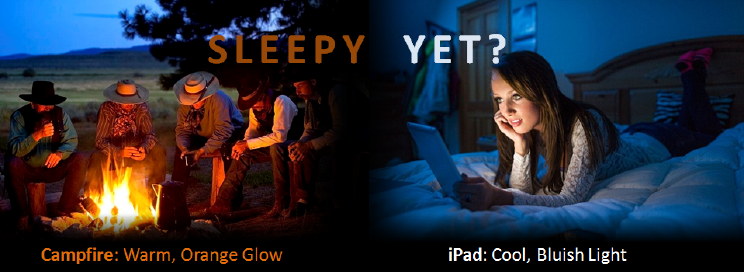
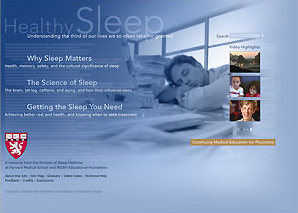
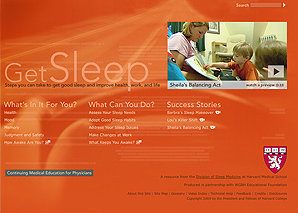
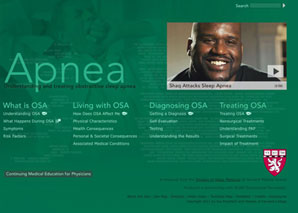
Blue light makes us hyper – can red light calm us down?
The blue part of the light spectrum is very strong in smart phones, tablets, television and other electronic devices with light-emitting screens. Blue light affects the biological clock and sleep-regulating neurons in the brain. Evening exposure, therefore, can make it difficult to settle down in the evening for a restful night of sound sleep.
Research has focused so strongly on blue light, that other colors of the spectrum have been neglected somewhat. Van der Meijden and colleagues from the Netherlands Institute for Neuroscience in Amsterdam have now for the first time systematically evaluated what happens after exposing ourselves to many minutes of intense red light only. Prior red light had some unexpected effects that were mostly opposite to the effects of blue light. After red light, it took participants more effort to perform a task requiring attention. Their reaction times also slowed. Most surprising, prior exposure to intense red light also made it easier to fall asleep. The findings, published today in Proceedings of the Royal Society B: Biological Sciences, suggest that red light might counteract some of the adverse effects of blue-light emitting screens. Red light may even turn out to be useful as night cap.
Here’s a YouTube video review of F.lux. It requires jail breaking the Apple iOS operating system, which voids the warranty, but I’m hopeful that iOS 7 will resolve that (fingers-crossed), and I’ll write about it if that happens.
Also, in this article, Arianna Huffington Implores You: Stop Taking Bright Devices Into the Bedroom. That may change if iOS 7 supports F.lux.
Great talking with you today, Wayne!
You’ll definitely want to see my talk “Color, Consciousness & Healing: The Healing Effects of Color, Light Frequencies & Art” where you’ll learn more about the simple science of why blue light from our ipads, tv’s etc, disrupts our sleep patterns through reduced melatonin production. You’ll also learn about the subsequent long-term negative health impacts of low melatonin levels. These are all problems that are easy to avoid with the right information.
See my youtube channel for the video of my talk: http://www.youtube.com/leannevenier
Best,
Leanne
Artworks Website: http://www.leannevenier.com
Add Leanne as a Friend on FACEBOOK: http://www.facebook.com/leannevenier